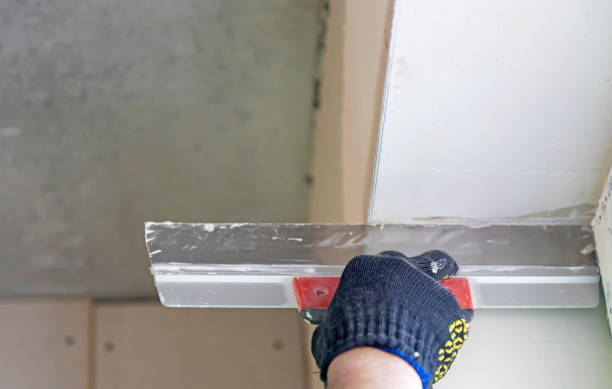
Choosing between plaster and drywall depends on your specific needs, budget, and the style you want to achieve. Both materials have their unique benefits and drawbacks, making the decision largely dictated by individual preferences and circumstances. In this article, we’ll explore the key differences between plaster and drywall, providing insights to help you make a well-informed choice.
Plaster: The Classic Choice
Plaster walls have been a staple in construction for centuries, known for their durability and high-end finish. Plaster is made from a mixture of lime, sand, and water, sometimes enriched with fibers to enhance strength. It’s applied wet and then allowed to dry, giving it a unique texture and appearance. This method allows for intricate details, making it a favorite in historic and custom homes.
One of the significant advantages of plaster is its robustness. Plaster walls are known for their strength and noise insulation properties, providing a solid, long-lasting wall that can withstand the test of time. However, plastering is labor-intensive and requires a skilled hand, which can make it a more expensive option compared to drywall.
Drywall: The Modern Standard
Drywall, also known as gypsum board, has become the go-to material for modern construction due to its ease of installation and cost-effectiveness. Made from a core of gypsum sandwiched between two sheets of heavy paper, drywall is quick to install and finish. It allows for faster construction timelines and is generally more affordable than plaster.
While drywall is less durable than plaster and more prone to damage from impacts, it is easier and cheaper to repair. This makes drywall an attractive option for many residential and commercial projects. The smooth finish of drywall also makes it ideal for painting and wallpapering, providing a versatile base for many interior design styles.
Installation Process Comparison
The installation process for these two materials is quite different. Understanding these differences is crucial for determining the right fit for your project.
- Plaster: The process begins with securing wooden or metal lath to the studs. Multiple layers of wet plaster are then applied and smoothed out. This labor-intensive process requires considerable skill and experience.
- Drywall: Sheets of drywall are cut to size and screwed or nailed to the wall studs. The joints between the sheets are taped and covered with joint compound, then sanded smooth. This process is quicker and often done by less specialized labor.
Cost Considerations
Cost is a significant factor when choosing between plaster and drywall. Plaster tends to be more expensive due to the labor and time required for installation. The materials themselves can also be more costly. On the other hand, drywall is generally more affordable and can be installed quickly, reducing labor costs significantly.
When planning renovations or new constructions, it’s essential to weigh the initial cost against the long-term benefits. While plaster may offer more durability and a higher-end finish, those on a tight budget might find drywall to be a more economical choice without sacrificing too much in terms of functionality and aesthetics.

Energy Efficiency and Insulation
Energy efficiency is another critical consideration in this debate. Plaster tends to provide better insulation due to its density, which can help maintain consistent temperatures within a home. This can lead to lower heating and cooling costs over time.
Drywall, while not as insulating as plaster, can be paired with modern insulation materials to achieve similar energy efficiency levels. This flexibility allows homeowners to customize insulation needs based on local climate conditions and energy-saving goals.
Conclusion
In conclusion, the choice between plaster and drywall depends on various factors including budget, desired aesthetic, and practical considerations like energy efficiency and durability. Plaster offers a timeless, durable finish ideal for historic or custom homes, but comes with higher costs and labor requirements. Drywall, on the other hand, provides a more cost-effective, versatile option suitable for most modern constructions.
Evaluating your specific needs and consulting with professionals can help you determine the best option for your project. Both materials have their unique advantages, making either a viable choice depending on the circumstances.
Frequently Asked Questions (FAQs)
What are the main differences between plaster and drywall?
The main differences lie in their composition, installation process, and cost. Plaster is a mixture of lime, sand, and water, applied wet and allowed to dry. Drywall consists of gypsum sandwiched between two sheets of paper and is quicker to install.
Which is more durable, plaster or drywall?
Plaster is generally more durable and provides better noise insulation. However, it is more costly and challenging to repair if damaged. Drywall is less durable but easier and cheaper to repair.
Is plaster more expensive than drywall?
Yes, plaster is typically more expensive than drywall due to the labor-intensive installation process and the cost of materials. Drywall is more cost-effective and quicker to install.
Can drywall be used in humid areas?
While standard drywall is not suitable for high humidity areas, there are moisture-resistant drywall options available, such as green board or blue board, which are designed to withstand humid conditions.
Does plaster provide better insulation than drywall?
Plaster does provide better insulation due to its density, which can help with energy efficiency. However, modern insulation materials combined with drywall can achieve similar levels of energy efficiency.


